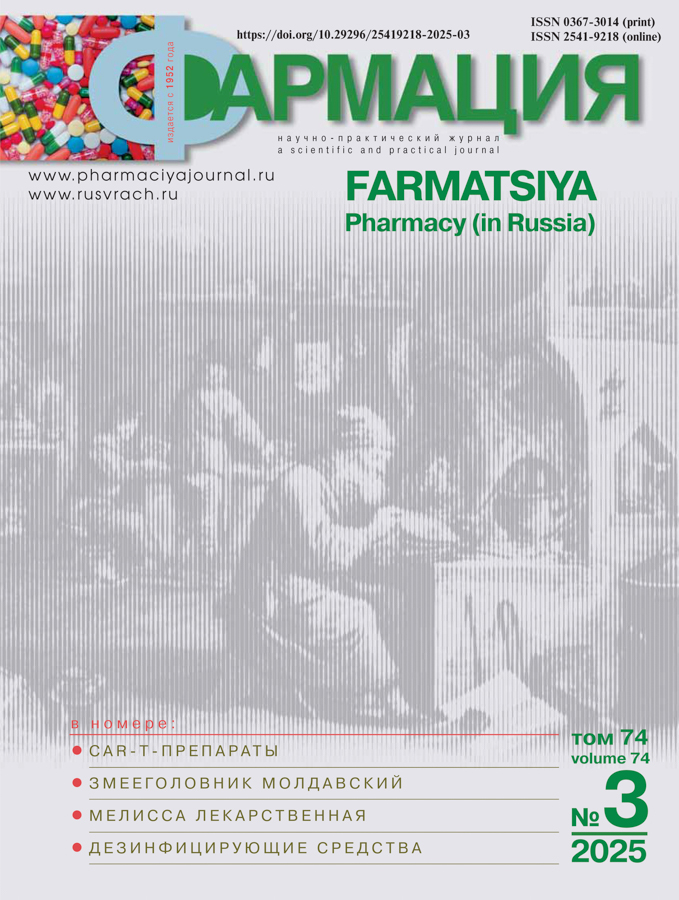Анализ ассортимента дезинфицирующих средств, применяемых на фармацевтических производственных предприятиях
- Авторы: Буковская Ю.А.1, Черных Т.Ф.1, Волков Н.И.1, Наркевич И.А.1
-
Учреждения:
- ФГБОУ ВО Санкт-Петербургский государственный химико-фармацевтический университет Минздрава России
- Выпуск: Том 74, № 3 (2025)
- Страницы: 43-49
- Раздел: Организация и экономика
- URL: https://journals.eco-vector.com/0367-3014/article/view/680115
- DOI: https://doi.org/10.29296/25419218-2025-03-06
- ID: 680115
Цитировать
Полный текст
Аннотация
Введение. Поддержание чистоты производственных помещений на фармацевтическом производстве является требованием системы норм, правил и указаний, предназначенных для поддержания качества производственного процесса, хранения и контроля качества продукции «Надлежащая производственная практика» (Good Manufacture Practice – GMP). Согласно стандартам GMP Российской Федерации и стандартам GMP Евразийского экономического союза, процедура использования моющих средств и дезинфектантов, разрабатываемая организацией самостоятельно, должна основываться на микробиологическом контроле и обеспечивать ротацию разных типов препаратов.
Цель исследования: анализ торговых наименований дезинфицирующих средств (ДС), используемых на 4 предприятиях для обработки помещений разных классов чистоты от A до D.
Материал и методы. В качестве параметров оценки были выбраны принадлежность активного ингредиента к той или иной группе согласно современной классификации дезинфектантов; страна происхождения; ценовой диапазон предложения из открытых источников; сфера применения и режимы обработки согласно инструкции по применению.
Результаты. Несмотря на различия в количестве наименований на каждом из фармацевтических производств, выявлено, что препараты содержат действующие вещества разной химической природы, обеспечивающие уничтожение любых микроорганизмов и предотвращение развития их резистентности. Комбинированные дезинфектанты преобладают в ассортименте используемых ДС. Чаще применяют концентраты или твердые формы для приготовления рабочих растворов, далее идут антисептики, предназначенные для санитарной обработки рук персонала и дезинфекции небольших по площади, труднодоступных поверхностей и оборудования. Большинство дезинфектантов отечественного производства. Инструкции по применению некоторых препаратов не содержат четкой информации о том, что они предназначены для использования на фармацевтических или иных предприятиях по изготовлению лекарств. Цены на изученные наименования, опубликованные в открытых популярных источниках, отличаются значительными колебаниями.
Заключение. Анализ ассортимента дезинфектантов, используемых на четырех фармацевтических производственных предприятиях, продемонстрировал использование препаратов разных групп по активному действующему веществу, что позволяет проводить эффективную дезинфекцию, разрабатывать индивидуальные режимы обработки помещений классов чистоты A, B, С, D, при этом осуществлять ротацию препаратов, как того требует стандарт GMP.
Полный текст
Об авторах
Юлия Александровна Буковская
ФГБОУ ВО Санкт-Петербургский государственный химико-фармацевтический университет Минздрава России
Автор, ответственный за переписку.
Email: ybukovskaya@mail.ru
ORCID iD: 0009-0001-9461-6281
соискатель кафедры микробиологии
Россия, 197376, Санкт-Петербург, улица Профессора Попова, д. 14, литера АТатьяна Федоровна Черных
ФГБОУ ВО Санкт-Петербургский государственный химико-фармацевтический университет Минздрава России
Email: tatiana.odegova@pharminnotech.com
ORCID iD: 0009-0000-1539-8013
доктор фармацевтических наук, профессор, заведующий кафедрой микробиологии
Россия, 197376, Санкт-Петербург, улица Профессора Попова, д. 14, литера АНикита Игоревич Волков
ФГБОУ ВО Санкт-Петербургский государственный химико-фармацевтический университет Минздрава России
Email: volkovnikita2006@yandex.ru
ORCID iD: 0009-0001-0986-5284
соискатель кафедры микробиологии
Россия, 197376, Санкт-Петербург, улица Профессора Попова, д. 14, литера АИгорь Анатольевич Наркевич
ФГБОУ ВО Санкт-Петербургский государственный химико-фармацевтический университет Минздрава России
Email: igor.narkevich@pharminnotech.com
ORCID iD: 0000-0002-5483-6626
доктор фармацевтических наук, профессор, ректор
Россия, 197376, Санкт-Петербург, улица Профессора Попова, д. 14, литера АСписок литературы
- Парахонский А.П. Проблемы формирования системы противомикробной защиты. Аспирант. 2016; 3 (19): 21–4. [Parakhonskii A.P. Problems of forming an antimicrobial protection system. Aspirant. 2016; 3 (19): 21–4 (in Russian)].
- Молчанова К.В., Полякова И.Н., Богданова О.Ю., Календарова А.В. Микробиота чистых помещений фармацевтических предприятий по производству гриппозных вакцин. Высшая школа: научные исследования: Материалы Межвузовского международного конгресса, Москва, 13 октября 2022 года. Москва: Инфинити, 2022; 81–8. [Molchanova K.V., Polyakova I.N., Bogdanova O.YU., Kalendarova A.V. Microbiota of clean rooms of pharmaceutical enterprises for the production of influenza vaccines. Vysshaya shkola: nauchnye issledovaniya: Materialy Mezhvuzovskogo mezhdunarodnogo kongressa, Moskva, 13 oktyabrya 2022 goda. Moskva: Infiniti, 2022; 81–8 (in Russian)].
- Матвиенко У.А., Переверзева Я.О., Анохина Т.А. Гигиеническая характеристика условий труда и состояние здоровья работающих в производстве антибиотиков. Бюллетень медицинских интернет-конференций. 2020; 10 (4): 154. [Matvienko U.A., Pereverzeva YA.O., Anokhina T.A. Hygienic characteristics of working conditions and health status of workers in the production of antibiotics. Byulleten' meditsinskikh internet-konferentsii. 2020; 10 (4): 154 (in Russian)].
- dezreestr.ru : официальный сайт. Доступно на http://www.dezreestr.ru/index.html [Accessed 30 September, 2023]
- dezr.ru : официальный сайт. Доступно на https://dezr.ru/?ysclid=lu08yparnn873858523 [Accessed 30 September, 2023]
- bibliodez.ru : официальный сайт. Доступно на https://bibliodez.ru/?ysclid=lu09080kew374209315 [Accessed 30 September, 2023]
- Бутко М.П., Попов П.А., Онищенко Д.А. Классификация дезинфицирующих средств и оценка их эффективности. Российский журнал Проблемы ветеринарной санитарии, гигиены и экологии. 2018; 3 (27): 134–42. doi: 10.25725/vet.san.hyg.ecol.201803024. [Butko M.P., Popov P.A., Onishchenko D.A. Classification of disinfectants and assessment of their effectiveness. Rossiiskii zhurnal Problemy veterinarnoi sanitarii, gigieny i ekologii. 2018; 3 (27): 134–42. doi: 10.25725/vet.san.hyg.ecol.201803024 (in Russian)].
- Гунар О.В., Доренская А.В., Булгакова Г.М., Сахно Н.Г., Изучение бактерицидности и фунгицидности некоторых антисептических лекарственных препаратов и дезинфицирующих средств. Х-фарм. Журнал. 2022; 56 (6): 48–53. [Gunar O.V., Dorenskaya A.V., Bulgakova G.M., Sakhno N.G., Izuchenie bakteritsidnosti i fungitsidnosti nekotorykh antisepticheskikh lekarstvennykh preparatov i dezinfitsiruyushchikh sredstv. KH-farm. Zhurnal. 2022; 56 (6): 48–53 (in Russian)].








